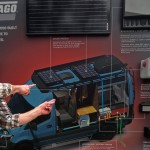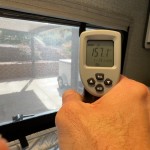This post may contain affiliate links.
What’s next, after I’ve tackled all the “big ticket” mods like electrical system upgrades, suspension improvements, and galley remodels? Well, now it’s time to turn my attention to things that were working as designed from day 1, but could do with some improvement. Which brings us to our RV’s water pump and this video! It’s a bit much to type, so watch, and you’ll understand.
To be completely clear – our water pump had been working just fine, and though I’m always open to upgrades, I wasn’t necessarily looking to enhance or replace it. The makers of the IRVWPC (Intelligent RV Water Pump Controller) reached out to us and offered us a unit in exchange for trying it out. When I saw the details on their product I immediately understood the benefits, because I had installed a VSD pump in our old RV Das Bus. So we agreed, and they sent the unit you see me install in the video.
At this point, we’ve had it installed for 6 weeks, we’ve taken it on a month-long road trip, and we’ve put about 6000 road miles on the RV with it. It’s held up well, and I see two main benefits to using the IRVWPC.
Safety Features
The safety features of the IRVWPC are what initially lured me in. You see, an RV’s water pump is a pretty simple device. All it really knows how to do is turn the pump on full blast or completely off. It doesn’t know how to detect or do anything about scenarios like the following:
- Running dry (which can overheat and damage the pump).
- Staying on for a month because you forgot to turn it off when you left your rig.
- Slowly leaking or dripping, which can cause water damage if you don’t detect it.
- Pumping out all your water at full blast if you have a burst pipe.
The IRVWPC has configurable safety features (you easily program it with tiny switches and dials) to address each of those potential problems. In our rig right now, we’ve enabled the protection for the first two.
Smoother Pump Operation
Your RVs water pump likely works just fine. Water comes out when you turn on the tap, and all is well, so I can’t say the IRVWPC is “essential”. But I will say that the smoother pump operation with the IRVWPC is definitely a “fit and finish” enhancement. It adds a level of refinement to your RV’s water system. This wasn’t my primary interest in the device in the first place, but it’s definitely something I appreciate now that I have it. It’s tough to describe, but the pump is just smoother and quieter. (So quiet, it’s tough to pick it up on our lavalier mics.) It’s like Grey Poupon for your water pump!

I’m probably dating myself here…
Some Final Words
I’ve got a final few observations on the IRVWPC. First, it can’t protect you from getting air in your water system somewhere. Air in your water system is bad, and it can cause pump surging and more noise from your pump until it works itself out. So when you drain and fill your tanks (while sanitizing for instance), count on having to purge any introduced air before the IRVWPC settles in.
The IRVWPC also can’t protect you from setting your pump’s pressure switch and the desired pressure on the IRVWPC in an incompatible way. Yeah. I did that. But in my defense, there were dials and switches, and I couldn’t resist the temptation to mess with them. In the end, I wound up putting all the pressure adjustments back where I found them, as that seemed to work best.
Another cool safety feature of the IRVWPC is that your pump’s “regular” pressure switch is still in the mix! Why is this important? Because if the IRVWPC were to completely fail for some reason, you’d still be able to use the water system just as you use it today.
A Couple Tool Links
This video wasn’t really about the tools, but a couple folks have pinged me about my electrical tools, so I’ll add a couple (affiliate) links here.
First are my Irwin Wire Strippers. When they work right, they’re stone cold awesome. And you can see them working right in the video. The downside of them is that some wire insulation doesn’t seem to work with them, and they come out of adjustment easily. But again, when they work right, they’re magic.
Second are my Klein Wire Cutters. I’ve had these for literally decades. I use them so frequently, I don’t even put them away. They just live on my worktop. Over the years, I’ve cut more than a few things I probably shouldn’t have with them, and I’ve dulled the blades. So one of these days I’ll get some more. But I’ll get the exact same thing.
So there you have it: my install and test of the IRVWPC. If you have any questions or comments, sound off below, and I’ll try my best to answer them (or find you an answer if I don’t know).
Cheers!











Hey James – just ordered this pump controller. I’ll let you know how the installation goes. Thanks for all the tips and tricks that you post.
Cheers,
Tom
Good luck! I think you’ll like it.
How is this holding up for you James? Would you still recommend installing it?
Still working exactly as it was the day it was installed.
If you want the benefits it provides (smoother flow, safety features), then it’s worthwhile.
I’ve come to really enjoy how quiet it makes our drinking water faucet (since I use that to make coffee while Stef is still asleep!).
James,
I just installed the IRVWPC in my 2022 Travato 59K. I am assuming I should be in TANK mode with the Truma Combi?
Thanks for your videos and comments
John
Yes, I believe TANK mode would be the appropriate setting for the IRVWPC in that setup.
Thanks James. My pump is much quieter and I have peace of mind when my wife leaves the pump on.
Thanks for this. I didn’t know this existed, and I too had the problem of hot then cold showers, when I was doing a “Navy” shower. I was going to install the one way valve like you did a while back, but I thought this product may kill two birds with one stone. IT DID!!! I didn’t have to put in the one way vavle, and I no longer get hit with hot or cold water when I stop the flow in the shower to lather up.
My wife and I also tested that when one of us is taking a shower, the other one can turn on a faucet, and not scald the person in the shower.
This product is a win, win win.
Great to hear!
I purchased a IRVWPC unit and completed the installation but I have been unable to get the system to work. I worked with Terry the owner ( by the way he is great ) of IRVWPC but he also could not figure out why the system will not work properly. I have a 2022 Travato KL and was wondering if the Volta system might be part of the problem. Would you have any suggestions as how to troubleshoot the system and isolate Volta or even how the Volta system might impact proper use of the IRVWPC. I have limited electrical skills. I really like your videos and appreciate all the work you do to help out the RV family.
Hmmm. You didn’t say exactly what problems you’re experiencing, but I’ll just guess they’re electrical from your post.
It’s an interesting theory that the Volta system might be responsible.
12v power in the Travato KL versions is provided from the 48v battery by means of a DC-DC voltage converter.
I don’t know much about the output of that converter, but if the voltage is too high, or not a true sine wave output, that may very well cause problems with the electronics in the IRVWPC.
If you have and know how to use a multimeter, that might be helpful. (Terry could guide you on exactly what measurements he needed to make a determination.)
Or, if you have one of those simple, plug-in voltmeters… even that might be helpful for diagnosing overvoltage.
Checking for true sine wave output is a bit more complicated I’m afraid.
Thanks for response. Terry thinks it is the DC-DC voltage converter causing a poor signal to the IRVWPC controller. He is working on a solution using capacitors inline before controller. Fingers crossed hope this works, if it does at least now he will have solutions for people with Volta system.
HELP!……….This is for the Ekko. Tried this mod…….first issue the negative on the pump goes to a white power plug in a fitting joined with a red wire. this popped out on me. the other side of the fitting is behind the side wall now. no way to get to it (can’t even feel the fitting with my fingers). removed a bunch of screws to try to take out the side wall out but looks like its secured in a way that I can’t get to the screws to take that side wall out. Also…..did you just wire into the negative (black) wire on that fitting,as there is no white wire. basically cutting the black wire in the middle and adding the module on both side of the black only? Any advise on how to get that side wall off or should I just try cutting into the wall, enlarging the existing space? that can’t seem to find the other end of that white plug. Any help would be greatly appreciated. Thanks
Oy! Sorry you’re having difficulty.
Well, here’s the easy bit: As far as what to connect to what, all I did was follow the wiring connections outlined in the videos on this page: https://www.irvwpc.com/videos. Their “detailed wiring” video even uses Winnebago wiring colors – the connectors are different though. I think the other side of the fitting you’re referring to has the white and yellow wires (the white would connect with the black on the pump).
As far as that fitting missing behind a wall… I don’t quite understand where it might have gone or what side wall you’re talking about. I can’t imagine that there was any tension on it to pull it someplace, so it just fell somewhere. I did not experience this, so I don’t have any specific advice for you other than to keep looking. That side of the connector will have the power and ground connections you need. Winnebago typically leaves plenty of slack in their wiring harnesses. So perhaps gently pull on other wires in that area. You’,, probably find the wires that are connected to that terminal, and should be able to pull it back into sight.
Good Luck!
Its like a ghost ,can’t find it, it was very tight to start with, I actually didn’t release it, I gave it a gentle tug to see if there was any slack and it came out. I was able to check the bottom, thinking it fell there (behind the side wall) but no luck. I am guessing is stuck with the other wires stuck under the vent piping. will keep looking but may have to rewire or cut into wall. Bad as no water now.
starting taking side wall out but realized, you have to take the bedframe out too, which is on top of side wall and to take the bed frame off you have remove the electrical wiring in the corner. seems like a nightmare, will put back the screws I took out of the side wall at least 20. Either cut into the wall or just rewire the pump to the battery seems the only choice?
If you rewired the pump directly to the battery, you would also have to wire in the switches. So that’s probably not a good option.
I looked at their videos, the ekko black connects to the white adapter, there is a red wire that also connects to the same connector (unlike in any of their videos). Can’t see the other side of the connector as its inside the side wall (inside the cutout with other wires and the black vent). Still have not found it. Thus I am assuming when I find the other side of the connector, I would only make one cut into the black wire and splice the two module connector into those two ends. Thanks
In the IRVWPC videos, the white and yellow wires are separate.
In the EKKO, those two wires are in the same connector, but you can cut the wires on either side of the connector and work with them separately if you like. You could even remove both halves of the connector entirely if you prefer.
Of course, first, you need to find the other half of your connector…
emailed IRVWPC and yep, just need to do 1 cut at the black cable ( in the middle between the pump and the WGO connector. connect controller purple to pump black and black controller to other side of black cut cable.
As far as finding the other side of connector, no luck…..there was no slack and the actually connector was inside the side wall where the tanks are. We think it’s probably stuck with some other wires in that area Still thinking of a game plan. At this point, either cutting in to side wall or perhaps removing the medal pan under the mattress (not sure how the pulley comes off from the black tin. wish we had a pipe scope, thus at least we can see where its at. will tackle it sometime tomorrow. Thanks
I can appreciate the nice and clean solution 🙂
I myself have been busy with a pressure sensor based system as a hobby project and so far I have still not ran out of features I want to add. Most notably my system as implemented right now also incorporates flow sensors that keep precise track of all water going out and coming in. It has made us much more confident about our water supply during boondocking sessions while it also helps us practice conservation by for instance telling us precisely how much water we used for our last shower. It has become a contest between me and my wife to see who can use the least water 🙂
With added flow sensors the number possible functions really explodes. For instance by turning the system off after a continuous use of more than a gallon of water I can prevent excessive water loss as no sane boondocker keeps his shower on for that long. Also, while filling the tank, instead of waiting until water starts to leak from underneath the RV the system warns me when the tank is full. Heck, it even shows the “time till full” 🙂 Another gimmick is that the system can estimate and warn us when we are about to run out of hot water when taking long showers.
Here is a clip of one of my first versions of the system: https://www.youtube.com/watch?v=IQ4ZZqxTmqo
How fun!
Lots of cool ideas for features there.
Hi James, perhaps I missed it in prior video, but what system do you guys use for the drinking water faucet that you have setup.
Thanks!
Mike
No prob.
I covered it in this video: https://www.thefitrv.com/rv-tips/what-my-rv-mods-are-really-like-installing-the-guzzle-h2o-water-filter/
Thanks for the vid, I’ll do this for our Ekko too.
James, could you remind me the name of those wire connectors you use? Thank you.
WAGO!!
I’ve watched most, if not all of your videos, which are great! I was wondering if you’ve been keeping track of the weight added or subtracted from all of your mods? We have made a few modifications to our Pleasure Way XLMB and verified by a CAT scale we are very close to the GVWR (11,030 lbs) when fully loaded.
I don’t weigh each mod separately, because that’s not important to me.
What IS important is the vehicle weight when fully loaded.
So, like you, we weigh when we’re fully loaded and headed out on a trip.
And also like you, we’re pretty darn close to our max GVWR.
So weight is a consideration on future mods.
Great vid thanks again. From a theoretical point of view – to throttle the pump speed, does the box vary the voltage, do you think? =Sal
It uses PWM (pulse width modulation).
https://en.wikipedia.org/wiki/Pulse-width_modulation
Does it require physical access to the device to adjust settings, or is there some sort of bluetooth type app to control it. Are the fittings long enough to mount it in a location that does require removing parts of the cabinet.
It does require access to the device to change the settings – but not while using the pump day-do-day.
There is no app-based control at present.
There are fittings supplied that should allow a variety of mounting options – and they’re standard plumbing fittings if you decide you want more options.
The IRVWPC can be fitted into any RV, so I can’t say for sure what you would have to do in order to mount it in your particular RV.
Does this have the same significant reduction in pump noise for all rv pumps? I have a Keystone Hideout trailer, and the pump is loud! It seemed like yours was making such little sound, it was hard to hear. Was it close to being that quiet before?
I can’t say if the noise reduction will be as great in your trailer, because pump noise depends on a lot of things. If your pump isn’t mounted with isolation mounts, it will be louder. If there are loose water pipes that can bang and rattle, it will be louder. If your pump doesn’t have flexible tubing making the connections directly to the pump, it will be louder. The list goes on…
I can say that the IRVWPC should definitely smooth out the operation of your pump. That in itself will reduce the noise for sure. But there may be other factors at work making your pump loud. Good Luck!!
I installed a IRVWPC that I really like. One additional benefit in my rig is that it makes consistent low flow much easier to achieve on the kitchen sink. I have a question for you: what are the benefits of the IRVWPC over the VSD? Why not install another VSD in #1? Thanks for all the fun videos!
The VSD pump will do something similar as far as smoothing out the flow – but it’s just a pump. There are no pressure controls you can adjust like the IRVWPC has. You take and use the pump as it is.
Also – the VSD pump will not get you any of the safety benefits of the IRVWPC at all. No run dry protection, no long-on protection, etc.
The install looked simple enough, at least until I realized you had to remove the platform that covers it up. The screws seem easy enough to remove but it looks like it’s sealed around the edges which gives me pause. How much hassle was it – on a scale of 1-5 for amateurs (not RV pros like you)?
It really wasn’t that bad.
If you’re starting with an empty cabinet, there are maybe 11 screws to remove and replace.
I’d give that part a 2/5.
The more difficult thing is finding room to install the pressure sensor without kinking or stretching any hoses or piping. That’s 3/5.
Was it necessary to cut and remount the fittings on any water lines? It looks as if the supply line had to be moved some and that’s not an easy type of water line to move.
Nothing was cut. And this is all on the output side of the pump, so no moving the supply line.
The output line was flexible hose. I was able to push it and bend it to fit without kinks.
That would be awesome. I will watch for it. Thanks for all you do!
James they didn’t give you a discount code eh. The price is 198.08 US dollars with shipping to Oregon. It’s nice that they are a Canadian company. They do provide a lot of installation advice and videos. I will probably order one but a discount would be nice.
No discount code, unfortunately.
They’re a pretty new, and fairly small company.
I would prefer an abbreviated install with your words of wisdom , definitely would be better than that loud music. I think I will install one of these in my Navion if the price point is not to bad. The Navion pump is right by your head on the Murphy bed. Jeff in Bend.
OK, now that you’ve tamed the supply side can you figure out how to tame the Gulper on the drain side? That’s what will wake folks up at night in my Ekko.
Leveling jacks… to prevent “random” running 😉
As far as running when you use the sink – I don’t have any ideas for that.
Wonder if it works with firefly systems?
Any downsides to the system from your experience?
The functions of the IRVWPC are pretty contained and only affect the water pump. I don’t see it integrating with Firefly in the near term.
No real downsides from our testing. The only possible one is that if it does turn the pump off due to a safety violation – it does that between the IRVWPC and the pump.
It can’t physically flip switches on your control panel, for example. So those switches will still tell you the pump is energized – even if it isn’t.
This is part of the “reprogramming of the humans” I mentioned. The fix is a simple off-on of the pump power. You just have to know when to do that.
Or – keep from triggering the safety in the first place… That always works! 🙂
What is the reset procedure when you do leave the pump switched on too long?
It’s easy. Just power cycle the pump. Off, then back on.
When I watch the video I get music instead of any dialogue during the installation? Is that what you intended?
Yep. That’s correct.
I started off talking, but my dialogue was vapid.
Trust me – the music is better.
Here’s the short version: Install the sensor. Hook up 3 wires according to the directions. Connect the sensor with the fitting that only connects one way. Mount the box.
But your vapid dialogue is entertaining, kind of like talking to one’s self. I actually enjoy it. Do you have a video on sanitizing? Newly purchased used unit and have never done it. One last thing. Noticed you were filming with a selfie stick there at the end. That wouldn’t have anything to do with suggesting some humans might need to be re-programed, would it?
Lol, no!
Stef just wasn’t around when I was ready to film the ending.
I haven’t done a video on sanitizing the water system. There are literally a bazillion videos out there on sanitizing an RV’s water system.
I have considered doing a video on the water system as a whole. It’s on my list.
I’m with Greg, I found the music in this (starting at 8:17 where you are talking right to camera with no dialogue) quite… let’s just say not ideal. I also noticed this in the video about the installation of the levelers. Much prefer a little dialog or VO about what’s going on instead of rockin’ music and subtitles.
I feel strongly enough about this that I left youtube just to come here to say it. (And I don’t like to do that)